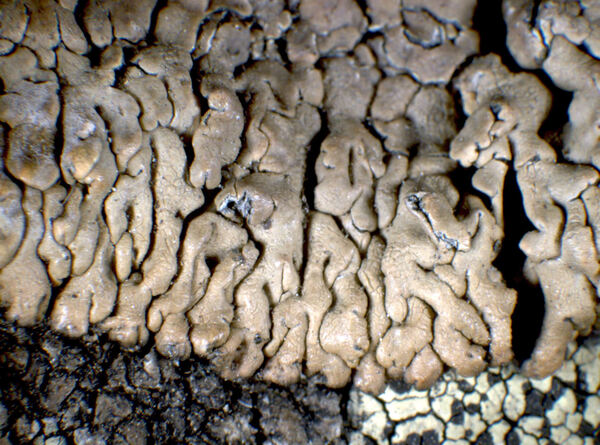Protoparmeliopsis muralis var. dubyi (Müll. Arg.) Hafellner & Türk
Stapfia, 76: 157, 2001. Basionym: Lecanora dubyi Müll. Arg. - Bull. Soc. Hallerienne: 36, 1853.
Synonyms: Lecanora muralis subsp. dubyi (Müll. Arg.) Poelt
Distribution: N - Frl, Ven (Nascimbene & al. 2021), TAA (Calatayud & al. 2013, Nascimbene & al. 2022), Lomb (Valcuvia & Delucchi 2001, Valcuvia & al. 2003, Delucchi & Valcuvia 2004), Piem (Isocrono & al. 2004, Isocrono & Piervittori 2008), VA (Matteucci & al. 2008c), Emil (Valcuvia & Delucchi 2001, Calatayud & al. 2013, Fariselli & al. 2020). C - Laz (TSB 8049), Sar (Rizzi & al. 2011, Giordani & al. 2013). S - Camp, Si (Ottonello & al. 1994, 2011, Ottonello & Romano 1997).
Description: Thallus crustose-placodioid to subfoliose, episubstratic, rather loosely attached, yellowish green to grey-green, areolate in central parts, lobed at margins, forming orbicular, up to 15 cm wide rosettes. Lobes much longer than wide (5-10 mm long, 0.7-1.5 mm wide), flat to usually convex, contiguous, smooth, usually epruinose; central areoles often with a thin dark margin. Upper cortex 50-75 µm (or more) thick, inspersed with yellowish granules soluble in K and insoluble in N, overlain by an epinecral layer; medulla white, rather loose but never becoming hollow; lower cortex poorly developed, mostly confined to the tips or margins of lobes. Apothecia lecanorine, 0.8-2 mm across, sessile, with a flat, rather dark brown disc and a smooth, persistent thalline margin. Epithecium pale yellow to brown, with granular crystals not dissolving in K; hymenium colourless, 50-80 µm high, I+ blue; paraphyses coherent, mainly simple or sparingly branched in upper part, the apical cells only slightly swollen; hypothecium colourless to yellowish. Asci 8-spored, elongate-clavate, very thin-walled, with a K/I+ blue, tall tholus penetrated by a faintly amyloid apical cushion, the wall K/I-, surrounded by a K/I+ blue outer layer, Lecanora-type. Ascospores 1-celled, hyaline, ellipsoid, 8-15 x 4-7 µm. Conidia thread-like. Photobiont chlorococcoid. Spot tests: thallus K- or K+ very pale yellow, C-, KC+ pale yellow, P- or P+ faintly yellow. Chemistry: cortex with usnic acid, medulla with zeorin and different triterpenoids.Note: on weakly calciferous or basic siliceous rocks in upland areas, with optimum near and above treeline. The var. schneebergensis (Zahlbr.) Hafellner & Türk is known from the Austrian Alps.
Growth form: Crustose placodiomorph
Substrata: rocks
Photobiont: green algae other than Trentepohlia
Reproductive strategy: mainly sexual
Commonnes-rarity: (info)
Alpine belt: rather common
Subalpine belt: common
Oromediterranean belt: rare
Montane belt: very rare
Submediterranean belt: absent
Padanian area: absent
Humid submediterranean belt: absent
Humid mediterranean belt: absent
Dry mediterranean belt: absent

Predictive model
Herbarium samples
Growth form: Crustose placodiomorph
Substrata: rocks
Photobiont: green algae other than Trentepohlia
Reproductive strategy: mainly sexual
Commonnes-rarity: (info)
Alpine belt: rather common
Subalpine belt: common
Oromediterranean belt: rare
Montane belt: very rare
Submediterranean belt: absent
Padanian area: absent
Humid submediterranean belt: absent
Humid mediterranean belt: absent
Dry mediterranean belt: absent

Predictive model
| Herbarium samples |
 INDEX FUNGORUM
INDEX FUNGORUM
 GBIF
GBIF
 DOLICHENS
DOLICHENS



